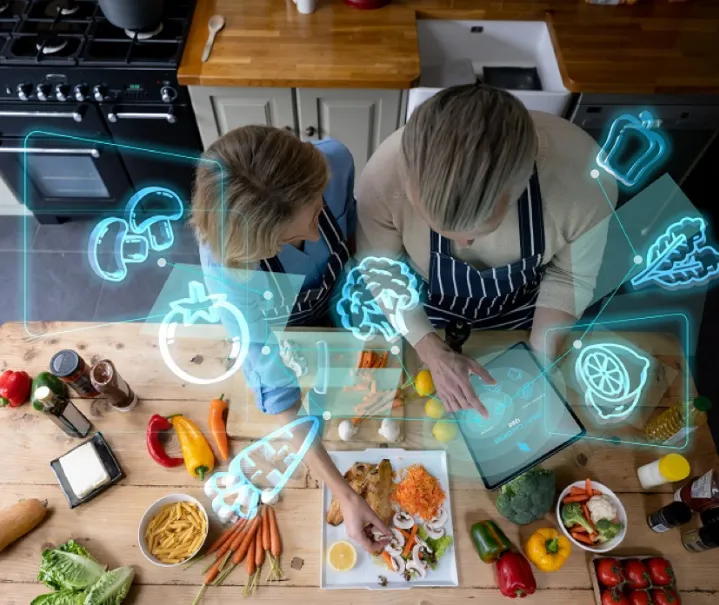Artificial intelligence is no longer a futuristic concept—it has become a driving force behind nearly every sector of our lives. While most people think of AI in connection with finance, healthcare, or e-commerce, one of its fastest-growing frontiers is food. From farm management to personalized nutrition, AI is reshaping how food is produced, delivered, and even consumed.
The global food industry faces enormous pressure: rising populations, climate concerns, food waste, and evolving dietary habits. Meeting these challenges with traditional methods is becoming increasingly difficult. That’s where AI comes in. Analysts predict the AI-powered food technology sector could surpass $27 billion by 2029, expanding at an annual growth rate above 30%. This surge reflects not only the promise of innovation but also the urgent need for transformation.
The Forces Driving Change
The world’s population is expected to approach 11 billion by 2050. With demand for calories and protein climbing, governments, businesses, and researchers are urgently searching for sustainable solutions. AI offers ways to optimize farming practices, strengthen supply chains, and make diets more environmentally responsible.
One notable example is Creative Food Labs in Mexico, which is using biotechnology to convert agricultural waste into healthier ingredients. By applying AI to scale and refine these processes, the company turns discarded raw materials into alternatives that reduce reliance on refined sugar and unhealthy fats. Initiatives like this highlight how technology and sustainability are beginning to converge.
Four Key Technologies Behind AI in Food
Researchers often point to four main approaches that are driving AI adoption in the food sector: expert systems, fuzzy logic, artificial neural networks (ANN), and machine learning (ML).
- Expert systems replicate human expertise by offering guidance on food quality, safety compliance, and hazard control. Global brands like Nestlé have leveraged these systems to refine product formulations.
- Fuzzy logic focuses on managing uncertainty, helping companies monitor conditions like storage temperature and humidity to extend shelf life.
- Artificial neural networks add predictive capabilities, enabling organizations to adapt recipes, improve consistency, and anticipate product quality issues.
- Machine learning connects the dots across the entire process, from predictive maintenance in factories to analyzing consumer feedback, helping businesses respond quickly and reduce costs.
Together, these technologies form the backbone of AI’s influence, transforming everything from the way crops are harvested to the way food is delivered to your door.
Innovation on the Consumer Side
AI’s presence isn’t limited to back-end systems. Increasingly, it’s shaping the experiences of everyday consumers. Companies like NotCo in Chile have gained attention for using AI platforms to design plant-based products that mimic animal-derived foods in taste, texture, and function. By analyzing molecular structures, NotCo is producing vegan alternatives that appeal to mainstream consumers while lowering environmental impact.
Meanwhile, Italian startup Robomagister has developed Liffo, an autonomous AI-powered cooking robot. Unlike traditional kitchen appliances that still require significant human input, Liffo independently prepares meals, freeing up users’ time. This innovation underscores a broader trend: AI isn’t just about improving efficiency in supply chains—it’s also becoming part of the dining experience itself.
In healthcare, too, AI is reimagining food. Platforms like RxDiet integrate medical data with AI-driven meal planning, offering tailored diets that align with patients’ nutritional needs. By bridging the gap between medicine and food, these tools are paving the way for “food as medicine” solutions.
Preparing for 2050 and Beyond
Looking ahead, the importance of AI in food will only grow. As the world approaches population and resource limits, traditional methods of food production won’t be enough. Precision agriculture powered by drones, self-driving farm equipment, and predictive analytics will be critical in managing crops. At the same time, AI-driven food science will accelerate the development of sustainable proteins and eco-friendly ingredients.
Ultimately, AI’s role extends across the entire food chain: upstream in farming, midstream in recipe and product development, and downstream in consumer services. The technology is becoming central to how we will feed billions of people more sustainably and efficiently.
We may not be able to eat AI, but in many ways, it will feed us—helping humanity respond to rising demand with precision, creativity, and responsibility.







